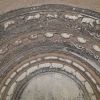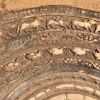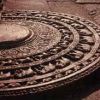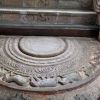සදකඩ පහන
The elaborate moonstone at its base is in itself a distinctive element of ancient sculpture in the island. These semi-circular slabs of granite or gneiss acquired increasingly complex bands of decorations over the years. They range from the near abstract tongues of fire and bands of creeper vines - to symbolic interpretations of the four perils of life
The latter consists of the elephant, a symbol of birth, the bull indicative of decay; the lion, resent in disease. and the geese, a symbol of death. Some also band of geese, which represents the dist between good, and evil. To some, the moon-stone is symbolic of transcending worldly temptations and achieving nibbane.
At the heart of many moonstones is a lotus petal. Buddhists regard the lotus as a sacred flower, a symbol of the male and female creative forces that prevails throughout Sri Lankan art, architecture, sculpture and literature. It figures in the legend attached to the birth of the Buddha, when seven lotuses sprang into bloom at his feet as he took the first seven steps of his life. The lotus bloomed again in profusion at the moment he reached the state of Enlightenment.
6th Century Gupta style carving. The woman, seated on the man's lap, lifts a warning finger, probably as a manifestation of her coyness; but the man carries on regardless."
The figures may represent Dutugemunu's son Saliya and the law caste (Sadol Kula) maiden Asokamala whom he loved. It's known that he gave up the throne for her.
Listing Details
Address








